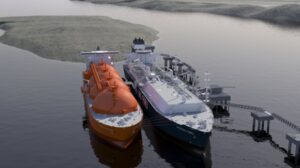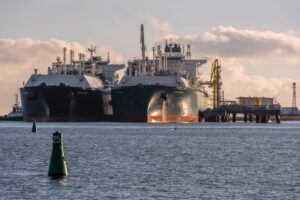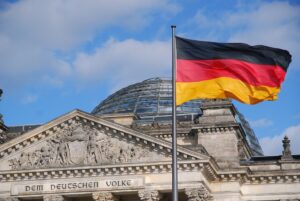The Polish-Hungarian cooperation should go beyond the historical proverb of brotherhood. We can work together on specific issues, but in some cases we will not be able to agree. The gravity of our partner imposes an appropriate scale in the evaluation of these possibilities – writes Wojciech Jakóbik, editor-in-chief of BiznesAlert.pl.
Orban speaks, Szijjártó acts
Prime Minister Mateusz Morawiecki visited Budapest on 3rd January. During a press conference with the participation of Prime Minister Viktor Orban, he said that the parties had talked about energy cooperation, including the Poland-Slovakia Gas Pipeline, which would open access to the LNG terminal in Świnoujście for Hungary. – For us, Hungarians, it is a matter of life and death to have gas pipelines from Hungary and to Hungary, with which we will have access to the Polish LNG terminal and to the non-Russian gas. The Hungarians and Slovaks have already built their sections (gas pipelines PPA). I encourage the Polish government to build a Polish-Slovak section together with the Slovaks (…) we will then have a corridor in which there will be no Russian influence – said the Hungarian Prime Minister during an interview with Krzysztof Ziemiec.
The expansion of gas connections between the Visegrad Group countries and Croatia takes place as part of the EU North-South Corridor programme, which includes, among others, the LNG terminal in Świnoujście. Owing to the financial support from the Connecting Europe Facility reaching 50 per cent, projects comprising the Corridor are gradually being implemented, but they have experienced delays in Poland and Hungary.
The Poles changed the construction schedule of the Poland-Slovakia Gas Pipeline, which was originally to be ready in 2020, but will eventually be built in 2021. The change was confirmed by the representative of the Ministry of Energy in an interview with BiznesAlert.pl. The Prime Minister of Hungary has therefore urged the government of Morawiecki to speed up the work that is also in the interests of his country. Words about life and death should be regarded as a rhetorical element, given the context.
A similar problem with the gas pipeline has arisen on the border between Hungary and Croatia and Romania. – Hungary has built capacity towards Croatia and Romania, from where we could receive additional sources of supply. However, neither Croatia, nor Romania, or as you wish the European Union, have prepared adequate infrastructure so that we could receive gas with the reverse. Hungary is blocked from the South – as stated by Orban, quoted by BiznesAlert.pl. However, interpretations vary. According to Romanians, it is the Hungarians who are blocking the development of supplies from alternative sources, such as the Neptune fields in Romanian territorial waters. The Hungarian FGSZ decided only to increase the capacity of the Romania-Hungary connection from 4.4 to 5.26 billion cubic metres per year. However, there will not be any section to Austria, which destroys the hopes of Exxon and OMV to export Romanian gas to the hub in Baumgarten. This will also affect the Commission’s plans concerning the Neptune field, which has already received EUR 179 million in funding for the implementation of the original plan, as I wrote in BiznesAlert.pl.
The fact that the Hungarians are able to play cynically and hide interests that are incompatible with the raison d’etat of Poland behind slogans about life and death, can be proved by the slap in the cheek that Budapest gave to Warsaw on the days of the Three Seas Initiative summit. Foreign Minister Péter Szijjártó signed an agreement with Gazprom’s President Alexei Miller on cooperation concerning the Turkish Stream project.
Budapest has consistently expressed its support for the Southern Corridor, i.e. the Azerbaijan’s gas pipelines to the European market, which will allow the Caspian raw material to be supplied also to Hungary, and it will provide an alternative to supplies from Russia in the next decade. However, supplies for Italian (8 billion cubic metres) and Bulgarian companies (2 billion cubic metres per year) were foreseen already at the first stage of the Transadriatic Gas Pipeline, which is to deliver the raw material of the Corridor from Turkey to Greece and Italy. Only after the extension would there be free capacity available for Hungarians, which is not yet a foregone conclusion. However, the Hungarian Prime Minister’s support for Turkish Stream is undermining the efforts of Central and Eastern Europe to obtain alternative sources of gas. It also strikes Ukraine, because Turkish Stream is calculated in a similar way as Nord Stream 2 to circumvent this transit country. The above actions are incompatible with the Polish interest.
The negative tone of Hungary’s policy is reinforced by Szijjártó’s commentary for Figyeloe weekly, which states that 'for physical and economic reasons, the provision of LNG from the USA via Poland would not be „appropriate”.’ This is a response to President Donald Trump’s proposal made at the Three Seas Initiative summit in Warsaw. He proposed to develop the supply of liquefied gas from the USA to the countries of the region.
Poland is building the Northern Gateway, i. e. the Norwegian Corridor called the Baltic Pipe and additional capacity of the LNG terminal in Świnoujście in order to be able to change the structure of supply contracts with an emphasis on reducing dependency on supplies from Russia. Gas from Norway and other directions, including LNG from the USA, can be shared with the neighbours, and according to ERU Trading it has already been done so in Ukraine. However, in the case of Hungary this will be difficult. It agreed that the contract with Gazprom, which ends in 2021, should be replaced by a new contract. It also reserved 900 million cubic metres of capacity available for the Russian company. The agreement on the use of Turkish Stream will allow imports of 6-9 billion cubic metres per annum from Russia starting from the end of 2019, provided that the pipeline is built. Hungarians use about 9 billion cubic metres a year in total. For now, imports from Russia are increasing. In the first eight months of 2017, deliveries to Hungary from this direction increased by 26.6%. There is a little room left for deliveries from Poland, but the words of Szijjártó about LNG from the USA are encouraging.
– We have then a corridor in which there will be no Russian influence – said Prime Minister Viktor Orban in TVP about the connection to the Polish gas port. The fact is that he is striving more for a corridor under total Russian control, i.e. the Turkish Stream, and there is no problem with this. Perhaps he hopes that the Polish public opinion will overlook this fact. We should avoid the evaluation of Hungarian politics on the basis of the slogans uttered by Prime Minister Orban.
Have proportion, my dear, dear Sir
Despite differences in energy policy, economic cooperation between Poland and Hungary is noticeably increasing. However, a proportion should be kept in assessing its prospects.
The Gross Domestic Product of our southern partner is 4.2 per cent year-on-year and, and after removing the seasonal and calendar factors, 3.8 per cent. The economy is accelerating after the slowdown noted in 2016, mainly due to industrial development. The EU funds and an increase in household consumption have helped, along with an improvement in the economic situation in Europe. In the period of January-March 2017, unemployment in Hungary fell to 4.5 per cent year-on-year, i. e. by 1.5 per cent. The average remuneration is HUF 303,000. According to the European Commission, the country will see economic growth of 3.6 per cent in 2017, followed by 3.5 per cent a year later. The OECD estimates that this figure will be 3.8 per cent and 3.4 per cent respectively. This organisation argues that due to lower government spending, investments have fallen last year, but are likely to see a significant increase again this year owing to the accelerated disbursement of EU funds.
Poland has so far signed 12 economic agreements with Hungary. They concern arbitration, vehicle, air and aviation transport, neighbourhood cooperation, investment protection, avoidance of double taxation, transport services, science, customs, and combined transport.
According to the Central Statistical Office, the Poland-Hungary trade turnover in 2016 amounted to EUR 8.015 billion, which means an increase of 4.6 percent compared to 2015. Poland’s exports amounted to EUR 4.828 billion (+1.1 percent), imports amounted to EUR 3.186 billion (+10.3 percent), while Poland’s positive balance was EUR 1.642 billion. Is it a lot? For comparison, in 2016, the trade turnover between Poland and Germany increased by about 5%, to EUR 101 billion. Exports from Germany to Poland amounted to approx. EUR 55 billion, imports from Poland to Germany amounted to approx. EUR 46.5 billion. This means that we import eighteen times more from Germany than from Hungary. We export over nine times more to our western neighbour than to St. Stephen’s country.
The most important partners of Hungarian imports in 2016 include Germany (EUR 22 billion, increase of 2.5%), Austria (EUR 5.3 billion, decrease of 1.6%), and Poland (EUR 4.6 billion, increase of 2.4%). In 2015 Poland still ranked sixth. This trend may continue, but an appropriate scale should be taken into account in assessing the potential of this cooperation.
No delusions, gentlemen
Hungary is pursuing a risky energy policy that makes it dependent on Russian gas. It does so because it probably views the potential of alternatives negatively: LNG supply via Poland and Croatia, or via the infrastructure of the Southern Corridor. For this reason, the Hungarian market cannot be expected to become an important direction of gas supplies from Poland if the Northern Gate construction plan is successful. Together with Hungary, Poles can compete for budgetary resources from the European Union. However, due to the limited prospects of cooperation with this country, the small scale of economic cooperation, and the risk of fraud resulting from the fact that Poland has assumed the role of Hungarian supplicant in a dispute with the European Commission, it is necessary to try to restore an appropriate proportion of this relationship.








